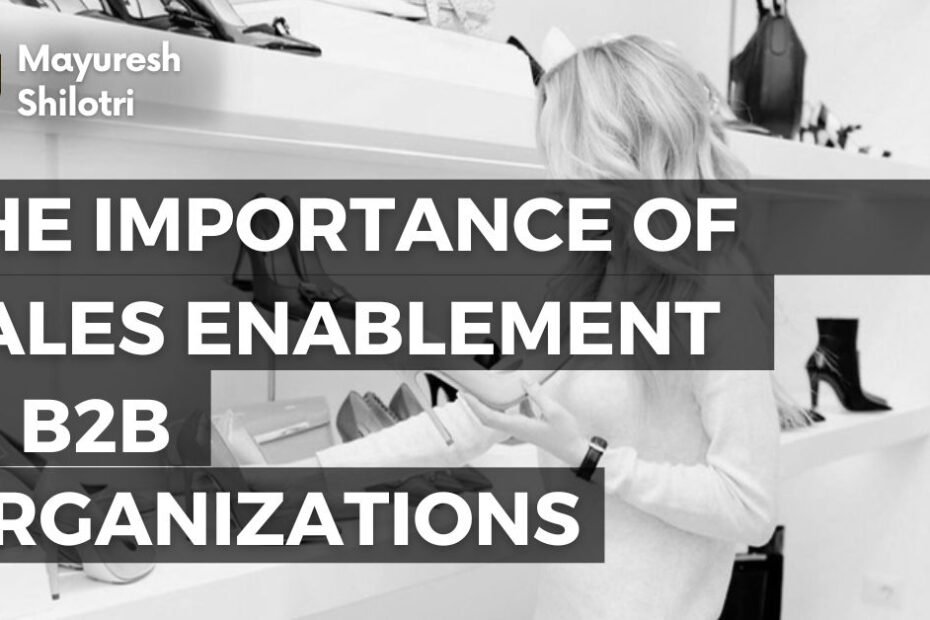Sales enablement in B2B organizations refers to the strategic process of equipping sales teams with the necessary tools, resources, and information to effectively engage potential customers and close deals. This encompasses a wide array of activities, including training, content creation, technology integration, and performance analytics. The primary goal of sales enablement is to enhance the efficiency and effectiveness of sales representatives by providing them with the right resources at the right time.
This ensures that they can address customer needs more effectively and navigate complex sales cycles with greater ease. In the context of B2B organizations, where sales processes can be lengthy and involve multiple stakeholders, sales enablement becomes even more critical. It involves understanding the unique challenges faced by sales teams, such as long decision-making processes and the need for personalized communication.
By implementing a robust sales enablement strategy, organizations can create a more informed and agile sales force that is capable of responding to the dynamic needs of their clients. This not only improves the chances of closing deals but also fosters long-term relationships with customers.
Key Takeaways
- Sales enablement in B2B organizations refers to the process of providing the sales team with the resources, tools, and information they need to effectively engage with prospects and close deals.
- Sales enablement plays a crucial role in driving revenue growth by equipping sales teams with the necessary knowledge and skills to effectively sell products or services.
- Sales enablement improves sales productivity by streamlining processes, providing relevant content, and offering training and support to sales representatives.
- Implementing sales enablement has a positive impact on customer experience by ensuring that sales teams are well-equipped to address customer needs and provide valuable solutions.
- Key components of a successful sales enablement strategy include aligning sales and marketing teams, providing ongoing training and support, and leveraging technology to streamline processes and access relevant data.
The Role of Sales Enablement in Driving Revenue Growth
Empowering Sales Representatives
When sales representatives are well-equipped with relevant information and tools, they can engage prospects more effectively, leading to higher conversion rates. Organizations that invest in comprehensive training programs and provide access to up-to-date market intelligence often see a significant increase in their sales performance.Personalized Pitches and Continuous Improvement
Effective sales enablement allows sales reps to tailor their pitches based on the latest trends and insights, making their conversations more relevant and impactful. Moreover, it fosters a culture of continuous improvement within sales teams. By regularly analyzing performance metrics and gathering feedback from sales representatives, organizations can identify areas for enhancement and implement targeted training initiatives.Data-Driven Decision Making
This iterative approach not only boosts individual performance but also contributes to overall revenue growth. For example, a company that utilizes data analytics to track the success of various sales strategies can pivot quickly when certain approaches are not yielding results, thereby optimizing their revenue-generating efforts.How Sales Enablement Improves Sales Productivity

Sales productivity is a critical metric for any B2B organization, as it directly correlates with the efficiency of the sales process and the ability to meet revenue targets. Sales enablement enhances productivity by minimizing administrative burdens on sales representatives and providing them with streamlined access to essential resources. For instance, by implementing a centralized content management system, organizations can ensure that sales reps have immediate access to the latest marketing materials, case studies, and product information.
This reduces the time spent searching for resources and allows them to focus on engaging with prospects. Additionally, sales enablement tools often include features such as automated reporting and analytics dashboards that provide real-time insights into sales performance. By leveraging these tools, sales teams can quickly assess their progress against targets and adjust their strategies accordingly.
For example, if a particular product is underperforming in a specific market segment, sales reps can be alerted to this trend and provided with tailored messaging or promotional materials to address it. This proactive approach not only enhances productivity but also empowers sales teams to make data-driven decisions that can lead to improved outcomes.
The Impact of Sales Enablement on Customer Experience
The customer experience is increasingly recognized as a key differentiator in today’s competitive B2B landscape. Sales enablement significantly impacts this experience by ensuring that sales representatives are well-prepared to meet customer needs and expectations. When sales teams are equipped with comprehensive knowledge about products, services, and industry trends, they can engage in more meaningful conversations with prospects.
This level of preparedness fosters trust and credibility, which are essential for building strong customer relationships. Furthermore, effective sales enablement allows for a more personalized approach to customer interactions. By utilizing customer data and insights gathered through various touchpoints, sales representatives can tailor their communications to address specific pain points or challenges faced by potential clients.
For instance, if a prospect has previously expressed concerns about implementation timelines, a well-informed sales rep can proactively address these concerns during their discussions. This level of personalization not only enhances the customer experience but also increases the likelihood of conversion as prospects feel understood and valued.
Key Components of a Successful Sales Enablement Strategy
A successful sales enablement strategy comprises several key components that work together to empower sales teams effectively. First and foremost is comprehensive training and onboarding programs that equip new hires with the necessary skills and knowledge to succeed in their roles. This includes not only product training but also insights into industry trends, competitive analysis, and effective selling techniques.
Organizations that prioritize thorough onboarding often see faster ramp-up times for new sales representatives. Another critical component is the development of high-quality content tailored to various stages of the buyer’s journey. This content should address common questions or concerns that prospects may have and provide valuable insights that position the organization as a thought leader in its industry.
Additionally, leveraging technology such as customer relationship management (CRM) systems and content management platforms can streamline access to this content, ensuring that sales reps have what they need at their fingertips.
The Importance of Sales Enablement in Aligning Sales and Marketing Teams

Sales enablement serves as a bridge between sales and marketing teams within B2B organizations, fostering alignment that is crucial for achieving common goals. When both teams collaborate effectively, they can create cohesive messaging that resonates with target audiences. Sales enablement initiatives often involve regular communication between these departments to ensure that marketing materials reflect the realities of the sales process and address the specific needs of prospects.
Moreover, aligning sales and marketing efforts through sales enablement allows for better tracking of lead quality and conversion rates. Marketing teams can gain valuable insights from sales representatives regarding which leads are most likely to convert based on their interactions. This feedback loop enables marketing to refine their strategies and focus on generating higher-quality leads that align with the organization’s objectives.
Ultimately, this alignment not only enhances operational efficiency but also contributes to improved revenue outcomes.
Measuring the Effectiveness of Sales Enablement Programs
To ensure that sales enablement programs are delivering value, organizations must establish clear metrics for measuring their effectiveness. Key performance indicators (KPIs) such as win rates, average deal size, and time-to-close are essential for assessing how well sales enablement initiatives are impacting overall performance. By tracking these metrics over time, organizations can identify trends and make data-driven decisions regarding their sales enablement strategies.
Additionally, qualitative feedback from sales representatives can provide valuable insights into the effectiveness of training programs and resources provided through sales enablement initiatives. Regular surveys or interviews can help gauge how well-equipped sales teams feel to engage with prospects and whether they find the available resources useful. Combining quantitative data with qualitative feedback creates a comprehensive view of program effectiveness, allowing organizations to make informed adjustments as needed.
Best Practices for Implementing Sales Enablement in B2B Organizations
Implementing an effective sales enablement strategy requires careful planning and execution. One best practice is to start by conducting a thorough assessment of existing processes and identifying gaps in resources or training. This baseline analysis will inform the development of targeted initiatives that address specific needs within the organization.
Another important practice is fostering a culture of collaboration between sales and marketing teams from the outset. Regular joint meetings or workshops can facilitate open communication and ensure that both departments are aligned on goals and messaging strategies. Additionally, investing in technology solutions that support seamless access to resources will enhance the overall effectiveness of sales enablement efforts.
Finally, organizations should prioritize ongoing evaluation and iteration of their sales enablement programs. The business landscape is constantly evolving, and what works today may not be effective tomorrow. By remaining agile and responsive to changes in market dynamics or customer preferences, B2B organizations can ensure that their sales enablement strategies continue to drive success over time.



